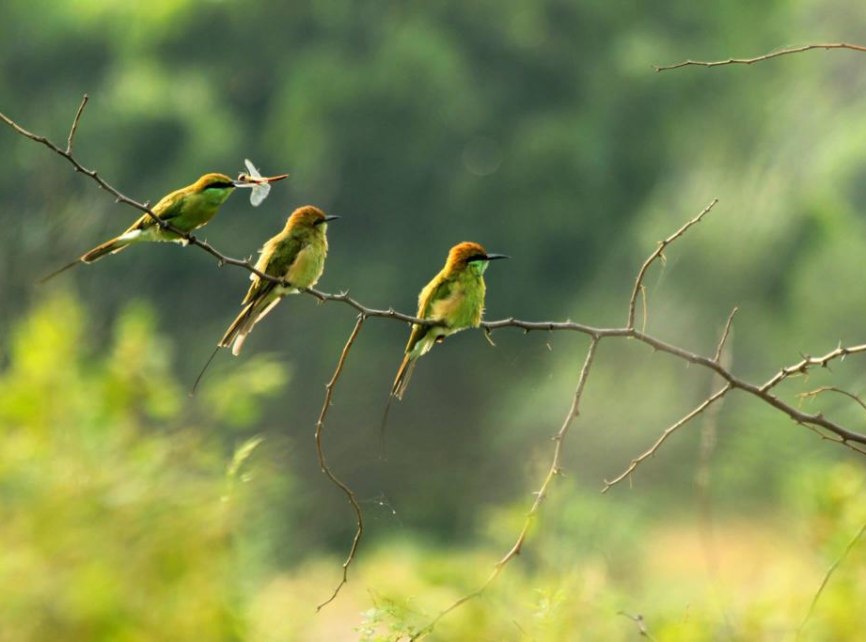A Reluctant Birder’s Guide to Birdwatching
The author hated birding for as long as she could remember, until she realised she doesn’t have to do it the way everyone else does
This piece first appeared on RoundGlass Sustain.
This year, I’ve had a regular avian visitor. It is some sort of sunbird, I reckon, because of the telltale long, curved beak, and a yellow and black body. It hops around on the grill outside my window, drinking water from the air-conditioner pipe but the minute I reach for my phone to take a photograph, it insolently takes flight.
We do this dance a couple of times every week. While I’d like to know what species and gender it is at some point, for now, I am just enjoying watching it for those few minutes.
I hated birding for as long as I could remember.
(Oh, put those pitchforks down, people, it’s quite all right).
Birdwatching started innocuously enough for me as it does for many wildlife enthusiasts — while chasing stripes in tiger reserves. Consequently, because I was working on a story more often than not, a lot of forays into the wild disintegrated into squinting at (seemingly) empty branches while companions gestured excitedly with a ‘look, a yellow-breasted so and so’. I would whisper an urgent ‘wait, what, who?’ But by the time I’d got the name down, we’d moved on to a ‘Look! A flame-backed that and this’. And I would be left craning my neck hoping to get a brief glimpse of a bird that I would continue to know nothing about, except that it had a flame-y back. This then spiralled downward into interactions about checklists with neat ticks next to names of lifers.(*gives you a moment to appreciate the seamless use of a birding term).
Okay, hate is a strong word; birding bored me to tears. And it troubled me that try as I might, apart from the occasional delight of a well-known bird — a pink flamingo or the colossal great hornbill, I could not connect with something that inhabited the wilderness that I was so passionate about. Nor could I partake in a hobby that had captured the imagination of nature enthusiasts the world over.
I realised I was doing this wrong. I was attempting to watch birds in the way I’d seen experienced birders do — immediately spotting birds, recognising them, following their flight path with binoculars. Also, unlike them, I was only looking in forests. And like all other wildlife watching that is restricted to national park boundaries, I wasn’t observing the wilderness at all.
I simply wasn’t there yet.
I needed a reboot. And it was best started closer home. Here’s why.
You don’t have to leave the city: While you will most definitely find richer biodiversity in jungles, you don’t need to head to a forest to get started. At the Karnataka Bird Festival 2018, Ramit Singal talked about ‘patch birding’ (birdcount.in/tag/patch-birding/). He encouraged the idea of visiting a space near your home and getting to know it better. He said you could just as easily do this from your window, but I preferred going outside. I picked a garden opposite my house, and started spending ten minutes after my morning run to look around the park. Easy. I couldn’t always see the birds, the canopies were high and dense, but I always heard them. I didn’t worry about the species, and I didn’t ask experienced birders to join me until I was able to tell the sounds apart, so it would be easier to retain information. I simply enjoyed listening to the ambient conversations over canopies without wanting to be a part of them.
You won’t miss the forest for the trees: It became about much more than just birds. At the patch I’d chosen, seasons were a revelation. In the monsoon, the green leaves shone with the deep cleanse of incessant rain. In summer, the only thing I registered was the flowering of the trees — gulmohars, golden showers, copper pods; my patch had looked up from its busy schedule and decided to dress up. I started to wonder if different birds preferred different trees (fruits notwithstanding).
In the summer, I started putting water and feed out on the balcony, and crows had monopolised that, cawing persistently when they didn’t find it ready. I later read that crows can recognise faces and along with awe, I spent a few (irrational?) minutes wondering if they’d attack me on my run if I stopped feeding them. Let these little steps lead to curiosity, and answers (if at all); not for any agenda, but to know your patch better
There is no right or wrong way to see wildlife but there is a definite one that works for you. Find it: Do whatever brings you closer to the wild. You learn more by making a checklist? Okay. You travel to see tigers and transition to birds? That’s fine. You plan your entire journey around one single species? It’s your party.
This isn’t a popular opinion, but I don’t believe that there is one correct way to fall in love with the wild. You do what works. I realised mine is through stories. I fell in love with the shrike the moment I heard that this tiny assassin impales its prey. Or that the drongo can mimic up to 30 different species of birds to further its own agenda.
You do need to look at birds in the city: When you start watching wildlife in your backyard, you develop empathy that years of travelling in the wilderness might not yield. You feel a kinship with the creatures that are breathing the same polluted air, living in the same filth, and are subject to the same high decibel levels as you are. You’ll see them as citizens, not unlike you. And while you keep checking on the upkeep of your patch, you might wonder about the neighbouring one, and the one beyond that. Maybe the entire city becomes your patch. Imagine how much empathy and concern you will invest in ensuring its health. Now imagine many more of you. Aasheesh Pittie, ornithologist and founder editor of the journal Indian Birds says in an interview featured on the Mongabay website: “The shift of human population is already placing a huge burden on the urban environment. It is a well accepted fact that natural life, be it birds, insects, reptiles, plants, amphibians, etc., are the best indicators of the health of the environment.” Maybe we’ll start to treat our backyards better because wild things are wild things, it really doesn’t matter where they live.
You will untangle your own conditioning: The biggest hurdle most people face is spotting and observing birds. They’re far away, fly off when you move closer, and then there are the colours, calls, sub-species — goodness, it’s a black hole (which I suspect is primed to scare us away). But but but, it’s okay. Stand your ground, rules and IDs be damned. Understand where this unfamiliarity comes from. We’re so used to watching larger animals that birds are far harder to keep pace with. Even when we see mammals for the first time in our lives, we know a lot of them from our alphabet books and whatnot – T for Tiger or E for Elephant or H for Horse. But hasn’t it always been just B for Birds. One blanket word for all birds, while different mammals got their own special alphabets. Just enjoy looking for birdlife. IDs can follow if at all.
It’s okay to take your time and just have fun: The coppersmith barbet has been part of my morning for years – its call and name in such delicious synchronicity. I realised how absolutely gorgeous it is only much later from a photo on a social media platform. I’ve since seen it in my patch and am delighted to report its absolute fearlessness of colourful attire. Point is, when you’re birdwatching in your backyard, you’re not on borrowed time. You don’t need to know everything immediately. Sometimes, this exercise becomes meditative, where you don’t even look up, but sit and enjoy being in a green space in a city that’s otherwise crowded and cacophonous.
First, just get to know your patch — the plant life in it, other creatures that frequent it, how it changes, and then you’ll see why it’s such a great home for the birds it hosts. By the time you get there, you’ll know more than you did, already.
Happy birding.




